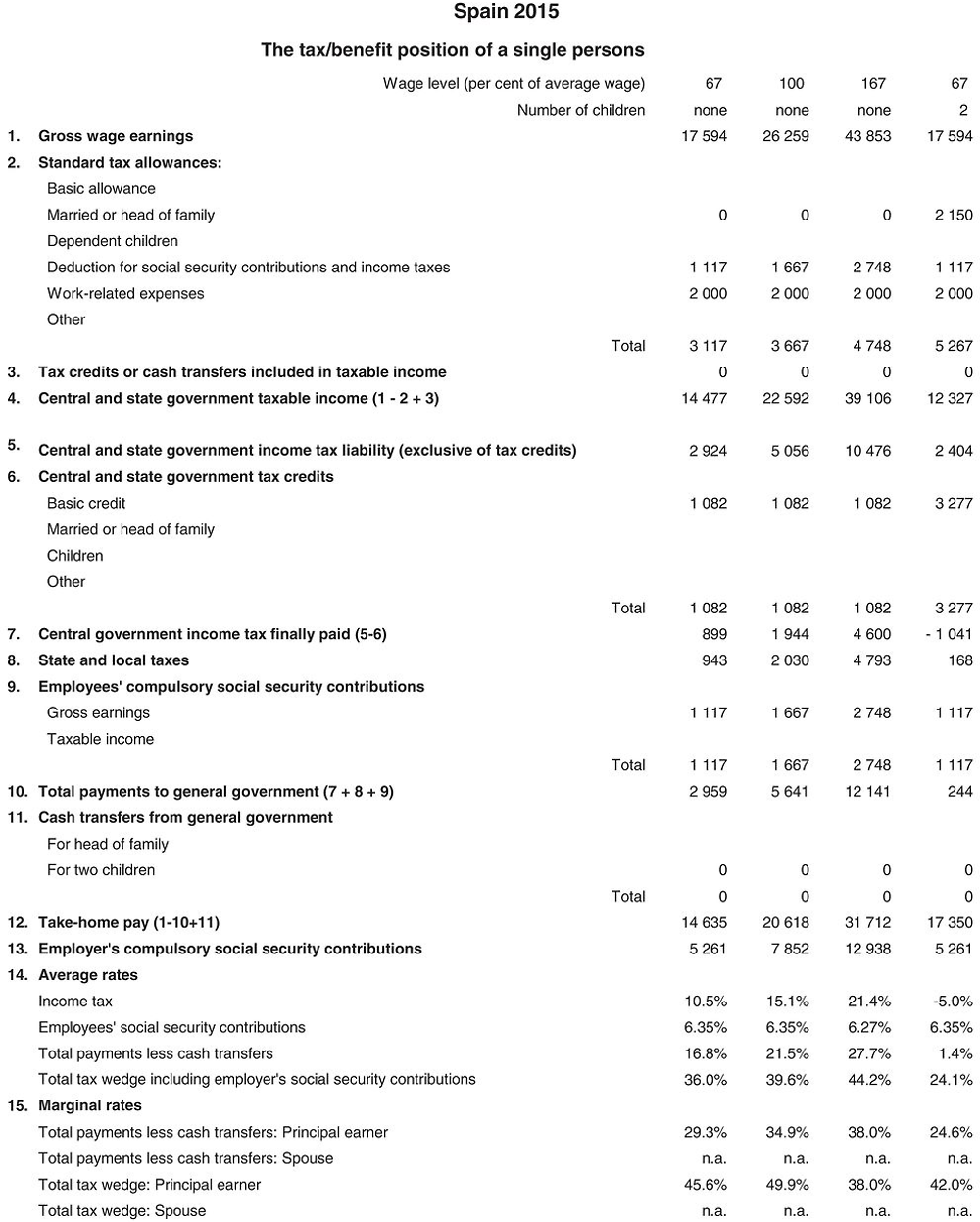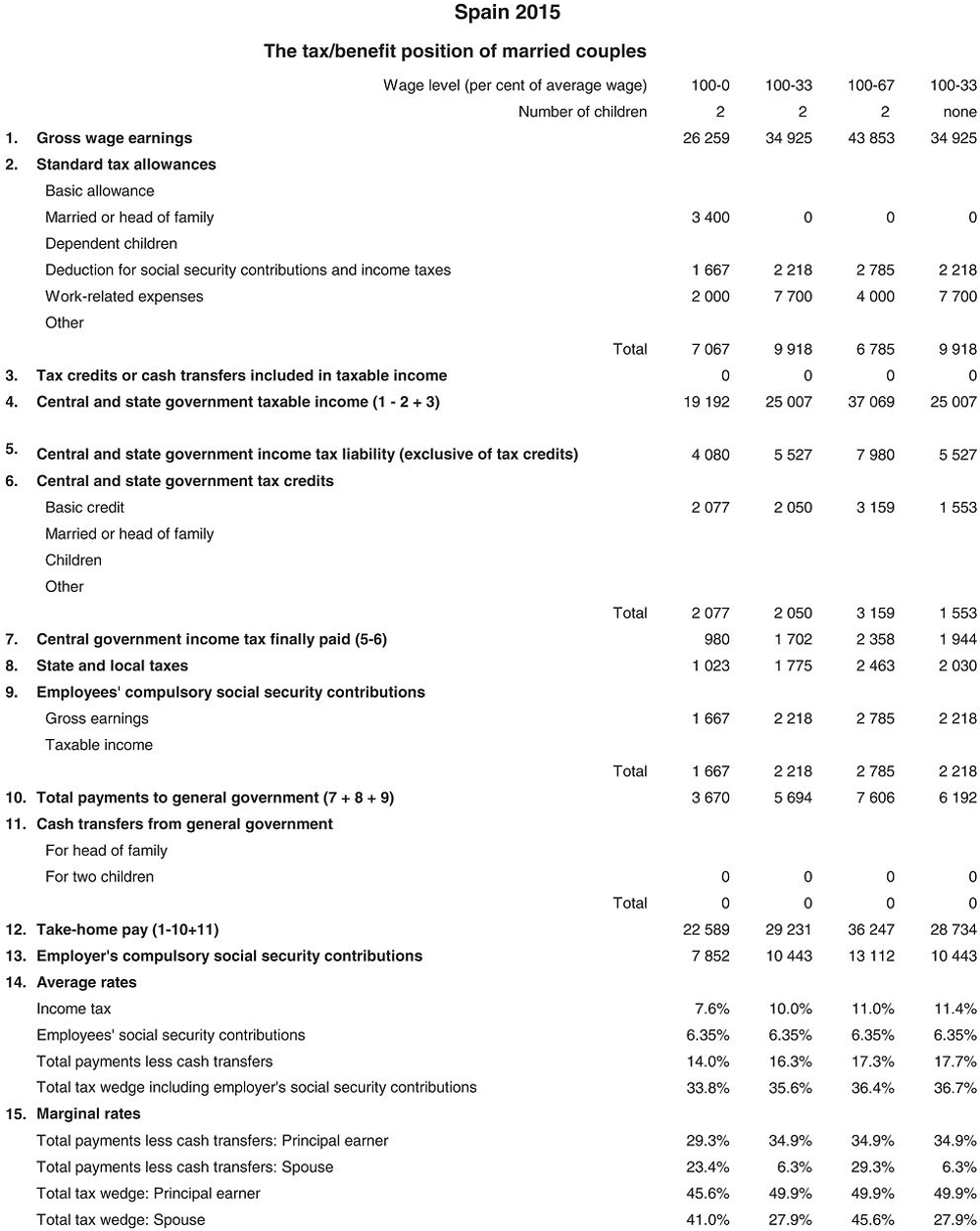Chapter. Spain
This chapter includes data on the income taxes paid by workers, their social security contributions, the family benefits they receive in the form of cash transfers as well as the social security contributions and payroll taxes paid by their employers. Results reported include the marginal and average tax burden for eight different family types.
Methodological information is available for personal income tax systems, compulsory social security contributions to schemes operated within the government sector, universal cash transfers as well as recent changes in the tax/benefit system. The methodology also includes the parameter values and tax equations underlying the data.
The national currency is the Euro (EUR). In 2015, EUR 0.90 was equal to USD 1. In that year the average worker earned EUR 26 259 (Secretariat estimate).
1. Personal income tax system
1.1. Central government income tax
1.1.1. Tax unit
As a general rule, the tax unit is the individual. Nevertheless, families have the options of being taxed:
-
As married couples filing jointly on the combined income of both spouses and dependents.
-
As heads of households (only unmarried or separated individuals with dependents).
1.1.2. Tax allowances and tax credits
1.1.2.1. Standard reliefs
-
Basic reliefs: Married couples filing jointly may claim an allowance of EUR 3 400. This figure amounts to EUR 2 150 for heads of households.
-
Maternity tax credit: a non-wastable tax credit addressed to working females with children under 3 years of age up to EUR 1 200.
-
Large families(3 or more children) or dependent family members with disabilities tax credits: this additional non-wastable tax credit (up to EUR 1 200) also may be claimed (within the Taxing Wages framework) by single-parent households with two children .
-
Relief for social security contributions: All social security payments are fully deductible.
-
Other expenses allowance: up to EUR 2 000, which may be increased by the same amount in case of accepting a job in a different location implying a change of residence.
-
Employment related allowance: Net employment income (gross income – employee social security contributions) may be reduced according to the following rules:
-
Taxpayers with net employment income equal or less than EUR 11 250: EUR 3 700.
-
Taxpayers with a net employment income between EUR 11 250.01 and EUR 14 450: EUR 3 700 less the result of multiplying by 1.15625 the difference between net employment income and EUR 11 250.
-
-
Disabled workers allowance: an allowance of EUR 3 264 for disabled salary earners. Those with reduced mobility may claim an augmented allowance of EUR 7 242.
As a result of the application of the above rules, net income cannot become negative.
1.1.2.2. Main non-standard reliefs applicable to an AW
-
Contributions to Pension Plans. Contributions made by each member of the household may reduce taxable income up to the lower of the following amounts:
-
30% of net income;
-
EUR 8 000.
-
Moreover, those households whose second earner has net labour income below EUR 8 000 may reduce taxable income up to a maximum of EUR 2 500 on a yearly basis if the principal earner contributes to a Pension Fund for the spouse.
-
Relief for subscriptions paid in respect of membership of a trade union and business or professional associations (last item is limited to mandatory membership) up to EUR 500.
-
Relief for expenses made for the legal defence of the taxpayer for labour-related conflicts up to a maximum limit of EUR 300.
Other non-standard reliefs provided as deductions are:
-
Investment in the acquisition and rehabilitation of own-housing: As a general rule, up to 1 January 2013, taxpayers were allowed to deduct from their tax liability 15% of the investment made during the year, up to a maximum of EUR 9 040.
-
Furthermore, disabled taxpayers were also allowed to deduct from their tax liability 20% of the investment expenses incurred in the repairs carried out for housing adaptation to the handicapped personal needs according up to a maximum of EUR 12 080.
-
With effect from 1 January 2013, the above tax credit has been abolished. Nevertheless, grandfathering rules apply for those taxpayers who before 1 January 2013 had acquired their main residence; had made some payments for it to be built; had made some payments for restoration/enlargement of their main residence or had made some payments to carry out the adaptation of the main residence of disabled people. However, in the latter two cases the works performed should be completed before 1 January 2017. For these taxpayers, the above tax credit can still be applied in accordance with the rules set up above.
-
Gifts: 50% of the amounts (below EUR 150) donated to the State (its different levels) public universities and othe qualifying institutions. For larger gifts, 27.5% on the excess, which may be increased to 32.5% when meeting certain conditions and 10% of the amount donated non-qualifying foundations or associations.
-
Investments and expenses in goods of cultural interest: 15% of the amounts granted to the importation, restoration, exhibition, etc. of certain goods listed in the General Register of Goods of Cultural Interest.
Each of these last two amounts cannot exceed 10% of taxable income.
1.1.2.3. Exempt Income
-
The base amount is EUR 5 550 per taxpayer. The same amount is granted for family units filing jointly. Taxpayers aged over 65 years may add EUR 1 250 to the former amount. Those aged over 75 years may claim additionally EUR 1 400.
-
Dependent children (under 25 years): EUR 2 400 for the first dependent child; EUR 2 700 for the second one; EUR 4 000 for the third, and EUR 4 500 for any additional child.
-
Child care allowance: an additional allowance of EUR 2 800 for each of the above dependent children under 3 years of age.
-
In case of disabled workers and additional amount of EUR 3 000 also applies. In case of great disability prior amount reaches EUR 9 000.
Child allowances have to be shared equally between spouses when they file separately.
1.1.3. Tax schedule
General rates of tax – resident individuals:
1.2. State and local income taxes
Regional rates of tax – resident individuals: (in case that Regional Governments do not exercise its rights to set their own tax rates).
2. Compulsory social security contributions to schemes operated within the government sector
Social Security contributions are assessed on the basis of employees’ gross earnings taking into account certain ceilings of gross employment income. In 2015, these ceilings are:
-
Lower ceiling: EUR 9 079.20
-
Upper Ceiling: EUR 43 272.
These ceilings are based on a full-time job. For part-time workers, ceilings are proportional to the real hours worked (the tax equations used for this Report do not take into account the lower ceiling).
2.1. Employees’ contributions
-
Old age pension/sickness and disability 4.7%
-
Unemployment 1.55%
-
Professional Training 0.1%
2.2. Employers’ contributions
-
Old age pension/sickness and disability 23.6%
-
Unemployment/Work injuries 5.50%
-
Wages fund 0.2%
-
Professional Training 0.6%
3. Universal cash transfers
3.1. Transfers related to marital status
None.
3.2. Transfers for dependent children
EUR 291 for 1-child families with annual gross earnings below EUR 11 547.96; the child transfer decreases with income between EUR 11 547.96 and EUR 11 814.71; the value is 0 for gross earnings exceeding EUR 11 814.71. EUR 582 for families with 2 children with annual gross earnings below EUR 13 280.15; the child transfer decreases with income between EUR 13 280.15 and EUR 13 813.65; the value is 0 for gross earnings exceeding EUR 13 813.65.
4. Main changes in tax/benefit systems in 2015
In 2015 the Spanish Government carried out a tax reform. Main PIT measures affecting earned income perceived by PIT taxpayers have been described above. Nevertheless, following SSC concessions also apply:
-
Aimed to foster new indefinite hirings, since 2 March 2014 employers hiring new workers under a non-fixed term contract (contracts between 25 February and 31 December 2014) may also apply a flat social security contribution (covering general risks). The flat contribution rate is: EUR 100 monthly contribution for full-time hirings (lower contribution also applies for part-time newcomers). The flat contribution will apply for a 24-month period.
-
Furthermore, since 1 March 2015 employers hiring new staff under a non-fixed term contract may claim a partial exemption on their SSC for the first EUR 500 of monthly salaries paid to workers. This SSC concession will apply for a 24-month period
5. Memorandum items
5.1. Identification of an AW and calculation of earnings
Refer to the information provided in the Annex of this Report.
2015 tax equations
The functions which are used in the equations (Taper, MIN, Tax etc) are described in the technical note about tax equations. Variable names are defined in the table of parameters above, within the equations table, or are the standard variables ”married” and ”children”. A reference to a variable with the affix ”_total” indicates the sum of the relevant variable values for the principal and spouse. And the affixes ”_princ” and ”_sp” indicate the value for the principal and spouse, respectively. Equations for a single person are as shown for the principal, with ”_sp” values taken as 0.


